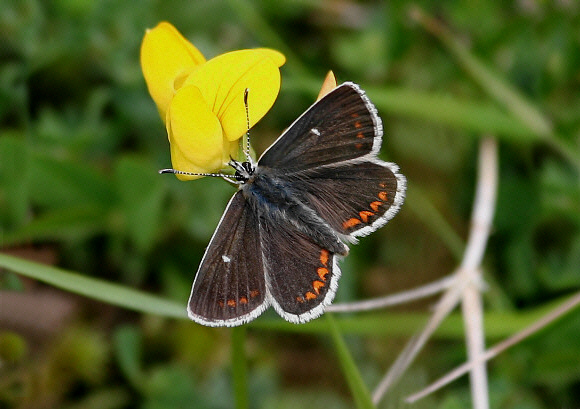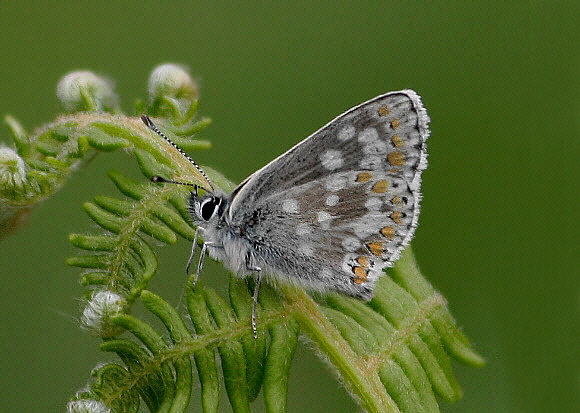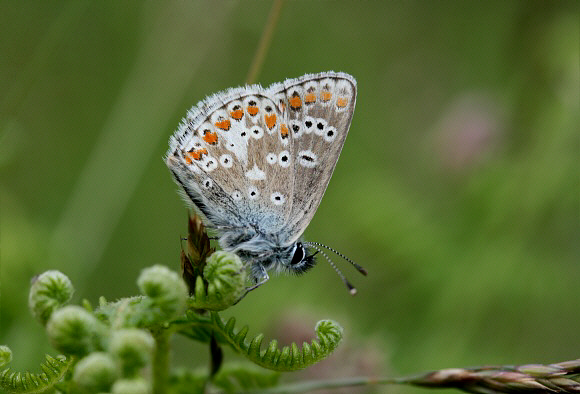 Aricia artaxerxes male, Sutherland – Tony Mainwood
Aricia artaxerxes male, Sutherland – Tony Mainwood
Introduction
The Northern Brown Argus, also known as the Mountain Argus or Scotch White-spot, is distributed patchily across Europe, occurring as a montane species in the Pyrenees, the Cantabrian mountains, Massif Central, the Alps and the Balkans but is absent from the Tatra and Carpathian ranges. It also occurs at lower elevations in northern England, Scotland and Scandinavia.
Unlike it’s close relative the Brown Argus Aricia agestis, it is single brooded, emerging in June and July, at which time agestis is “between broods”.
In Britain the ranges of the 2 species do not overlap. In Europe however they often share the same habitats, and there is a degree of overlap in the flight periods.
The populations in northern England are known as form salmacis. They closely resemble agestis on both wing surfaces. Scottish specimens however have a prominent white spot in the discal cell of the forewings, and the white spots on the undersides are devoid of black centres.
 Aricia artaxerxes male, Sutherland – Tony Mainwood
Aricia artaxerxes male, Sutherland – Tony Mainwood
Habitats
This is primarily an alpine and arctic species – a relic of the time when butterflies recolonised Britain following the retreat of the last Ice Age about 12,000 years ago. As the climate warmed, artaxerxes became restricted to northern England and Scotland where temperatures were cooler, and at the same time the Brown Argus Aricia agestis colonised the warmer parts of Britain further south.
In Scotland it is found in a variety of habitats including cliff tops, south-facing hillsides, open areas within woodlands, and grassy embankments. It occurs at altitudes as high as 450m.
In northern England form salmacis is found at well drained grassland habitats, typically in sheltered pockets on limestone pavements or rough grassy hillsides where there are patches of scree.
The butterflies are very sedentary in behaviour, with the result that all colonies are highly localised and consequently there is little genetic interchange between adjacent populations. The majority of colonies however currently appear to be stable, although climate change threatens the butterfly’s long term future in Britain.
 Aricia artaxerxes form salmacis Arnside Knott, Cumbria – Emily Halsey
Aricia artaxerxes form salmacis Arnside Knott, Cumbria – Emily Halsey
Lifecycle
The butterflies emerge from mid June to early July depending on location, and lay their eggs singly on the upper-side of leaves of common rockrose Helianthemum chamaecistus.
The young caterpillar feeds in a similar manner to agestis, nibbling at the underside of the leaves, but leaving the cuticle intact, creating a distinctive pattern of tiny holes visible from above. During the winter months it hibernates amongst withered leaves at the base of the foodplant Helianthemum chamaecistus. When fully grown in May the larva feeds openly on the upper surface of the leaves, and is attended by ants. It is pale green with a pale pinkish stripe below the spiracles.
The chrysalis is formed in late May on the ground, and is also attended by ants, which cover it with soil and fragments of vegetation.
Adult behaviour
At it’s habitats in northern England this species nectars at bird’s foot trefoil, thyme and many other low growing flowers, but in Scotland I have often seen it nectaring at tall thistles. The butterflies are active only in warm sunshine, fluttering amongst grasses, and basking periodically on low herbage or patches of bare ground.
I have not observed courtship or copulation in this species, but it is likely to follow a similar pattern to that of agestis, in which both sexes roam freely, and copulate within a few seconds of meeting.
In dry weather the adults roost overnight on grass heads. During wet spells they hide away among bracken, bramble or other herbage, roosting on the underside of leaves.
